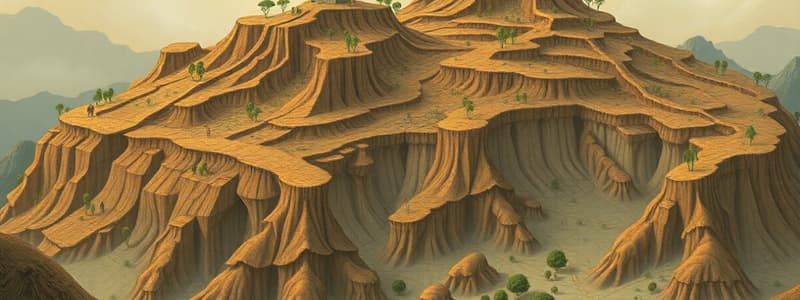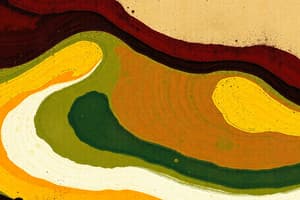Podcast
Questions and Answers
What is defined as a change in soil health leading to diminished ecosystem capacity?
What is defined as a change in soil health leading to diminished ecosystem capacity?
- Soil compaction
- Soil erosion
- Soil degradation (correct)
- Soil salinization
Which human activity is primarily responsible for exposing soil and increasing erosion?
Which human activity is primarily responsible for exposing soil and increasing erosion?
- Pollution
- Soil salinization
- Deforestation (correct)
- Urbanization
What percentage of soil used in agriculture is identified as degraded or severely degraded?
What percentage of soil used in agriculture is identified as degraded or severely degraded?
- 50%
- 30%
- 20%
- 40% (correct)
One consequence of soil degradation is increased flooding due to:
One consequence of soil degradation is increased flooding due to:
How can crop rotation mitigate soil degradation?
How can crop rotation mitigate soil degradation?
Which of the following practices can lead to soil compaction?
Which of the following practices can lead to soil compaction?
Overgrazing by animals can contribute to soil degradation primarily by:
Overgrazing by animals can contribute to soil degradation primarily by:
Which of the following is NOT a direct consequence of soil degradation?
Which of the following is NOT a direct consequence of soil degradation?
What defines soil texture?
What defines soil texture?
Which soil horizon is primarily composed of loose or partly decayed organic matter?
Which soil horizon is primarily composed of loose or partly decayed organic matter?
What does the process of eluviation involve?
What does the process of eluviation involve?
Which horizon is characterized by the accumulation of clay and nutrients from above?
Which horizon is characterized by the accumulation of clay and nutrients from above?
What happens to recently deposited soil material, such as from a flood?
What happens to recently deposited soil material, such as from a flood?
What factor does NOT influence the variations seen in soil profiles?
What factor does NOT influence the variations seen in soil profiles?
How is the soil textural triangle used in soil science?
How is the soil textural triangle used in soil science?
Which statement about the C horizon is true?
Which statement about the C horizon is true?
What is the main distinction between soil and dirt?
What is the main distinction between soil and dirt?
Which of the following correctly describes the term 'pedosphere'?
Which of the following correctly describes the term 'pedosphere'?
Which human activity is likely to have a positive effect on soil quality?
Which human activity is likely to have a positive effect on soil quality?
What factor does NOT influence the formation of soil?
What factor does NOT influence the formation of soil?
How does human waste disposal impact the soil?
How does human waste disposal impact the soil?
What is an important benefit of soil for the environment?
What is an important benefit of soil for the environment?
Which of the following is NOT a focus of soil science?
Which of the following is NOT a focus of soil science?
Why is it essential to conserve and protect soil?
Why is it essential to conserve and protect soil?
Which soil type is classified as a frozen soil found in the coldest regions on Earth?
Which soil type is classified as a frozen soil found in the coldest regions on Earth?
What type of soil is primarily characterized by its high organic content and wet conditions?
What type of soil is primarily characterized by its high organic content and wet conditions?
Which of the following soil orders is associated with dryland conditions?
Which of the following soil orders is associated with dryland conditions?
Which soil type is predominantly formed from volcanic ash?
Which soil type is predominantly formed from volcanic ash?
What role do soils play in regulating water and filtering potential pollutants?
What role do soils play in regulating water and filtering potential pollutants?
Which soil type is known for being slightly developed and often found on steep slopes?
Which soil type is known for being slightly developed and often found on steep slopes?
Which soil order is highly weathered and commonly found in tropical climates?
Which soil order is highly weathered and commonly found in tropical climates?
How does soil contribute to mineral deposit production?
How does soil contribute to mineral deposit production?
What is the main goal of the Ecological Solid Waste Management Act of 2000?
What is the main goal of the Ecological Solid Waste Management Act of 2000?
What does the waste management hierarchy emphasize?
What does the waste management hierarchy emphasize?
What specific action has been mandated by the RA 9003 regarding waste collection?
What specific action has been mandated by the RA 9003 regarding waste collection?
What are materials recovery facilities (MRFs) responsible for?
What are materials recovery facilities (MRFs) responsible for?
Which of the following practices is promoted to address the issue of plastic waste?
Which of the following practices is promoted to address the issue of plastic waste?
What negative environmental impact is associated with improper waste disposal?
What negative environmental impact is associated with improper waste disposal?
Why are sanitary landfills preferred over dump sites?
Why are sanitary landfills preferred over dump sites?
What is recommended for reducing waste at the source?
What is recommended for reducing waste at the source?
Study Notes
Soil Degradation
- Soil degradation is a change in soil health that leads to diminished ecosystem capacity.
- Human activity primarily responsible for exposing soil and increased erosion is agriculture.
- 33% of agricultural soil is degraded or severely degraded.
- Increased flooding is a consequence of soil degradation, due to reduced infiltration.
Mitigating Soil Degradation
- Crop rotation helps mitigate soil degradation by introducing different crops with varying nutrient requirements, improving soil structure, and suppressing pests.
Soil Compaction
- Tilling, heavy machinery use, and overgrazing can lead to soil compaction.
Consequences of Overgrazing
- Overgrazing contributes to soil degradation by reducing vegetation cover, increasing soil erosion and compaction, and damaging soil structure.
Soil Degradation Consequences
- Soil degradation leads to reduced crop yields, increased pollution, and loss of biodiversity.
Soil Properties
- Soil texture refers to the relative proportions of sand, silt, and clay particles.
- The O horizon is primarily composed of loose or partly decayed organic matter.
- Eluviation involves the leaching of materials from the upper soil layers, such as organic matter and nutrients.
- B horizon is characterized by the accumulation of clay and nutrients from above.
- Recently deposited soil material, such as from a flood, undergoes weathering and decomposition to become part of the soil profile.
Factors Affecting Soil Profiles
- Climate, parent material, topography, and organisms influence variations seen in soil profiles.
- Soil textural triangle helps determine soil texture based on the proportions of sand, silt, and clay.
C Horizon
- The C horizon is the least weathered soil horizon and is closest to the parent material.
Soil vs. Dirt
- Soil is a complex, living ecosystem, while dirt is a finer, inert substance.
Pedosphere
- The pedosphere encompasses the Earth's soil layer, its properties, and its interactions with the environment.
Positive Impacts on Soil Quality
- Sustainable agricultural practices, such as cover cropping and no-till farming, have positive effects on soil quality.
Soil Formation
- Time, climate, parent material, topography, and organisms all contribute to soil formation.
Human Waste Disposal
- Human waste disposal can impact soil through contamination with pollutants and spreading diseases.
Soil Benefits
- Soil plays an important role in filtering water, providing habitat for organisms, and sequestering carbon.
Soil Science Focus
- Soil fertility, soil structure, and soil biota are the main focus areas of soil science.
Importance of Soil Conservation
- Conserving and protecting soil is crucial for food security, environmental health, and sustainable development.
Soil Types
- Gelisols are frozen soils found in the coldest regions.
- Histosols are soils with high organic content and wet conditions.
- Aridisols are dryland soils.
- Andisols are soils formed from volcanic ash.
Soil Roles
- Soils regulate water flow and filter potential pollutants, contributing to environmental regulation.
Soil Development
- Entisols are slightly developed soils often found on steep slopes.
Tropical Climates
- Oxisols are highly weathered soils found in tropical climates.
Mineral Deposit Production
- Soils contribute to mineral deposit production through weathering and leaching processes.
Ecological Solid Waste Management Act of 2000
- RA 9003, the Ecological Solid Waste Management Act of 2000, aims to promote environmental protection, resource conservation, and waste management.
- The law emphasizes a waste management hierarchy prioritizing reduction, reuse, recycling, and disposal.
- RA 9003 mandates segregated waste collection.
Materials Recovery Facilities (MRFs)
- MRFs sort and process recyclable materials.
Addressing Plastic Waste
- Composting is a practice promoting waste reduction.
Improper Waste Disposal
- Pollution of air, water, and soil is a negative impact of improper waste disposal.
Sanitary Landfills
- Sanitary landfills are preferred over dump sites due to their controlled waste containment and reduced environmental hazards.
Reducing Waste at the Source
- Reuse, recycling, and composting are recommended for reducing waste at the source.
Studying That Suits You
Use AI to generate personalized quizzes and flashcards to suit your learning preferences.
Related Documents
Description
This quiz explores the concept of the pedosphere, its significance as the Earth's soil layer, and the fundamental aspects of soil science. Participants will learn about soil formation factors, including parent material, climate, topography, and biological activity, and how these elements interact over time. Test your knowledge on the characteristics and classification of soil in this informative quiz!



